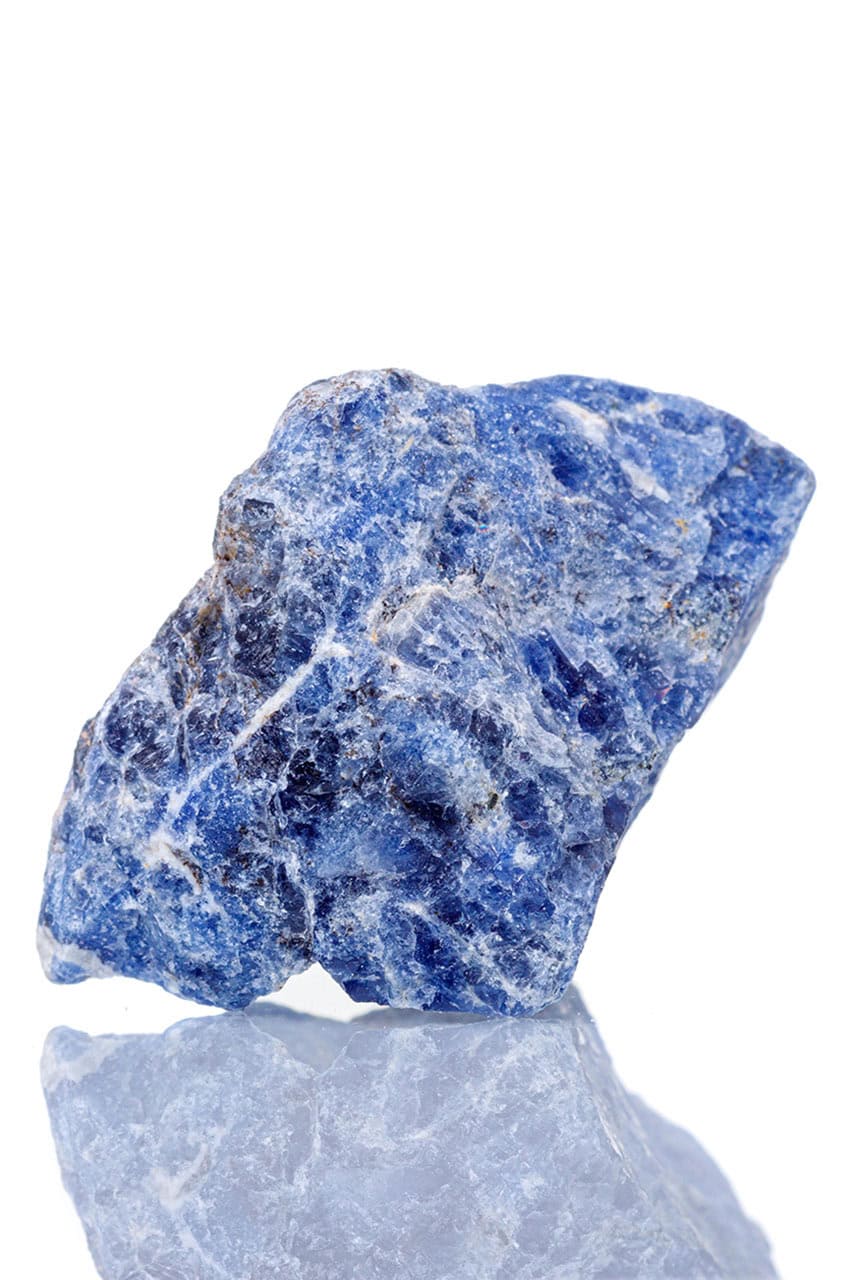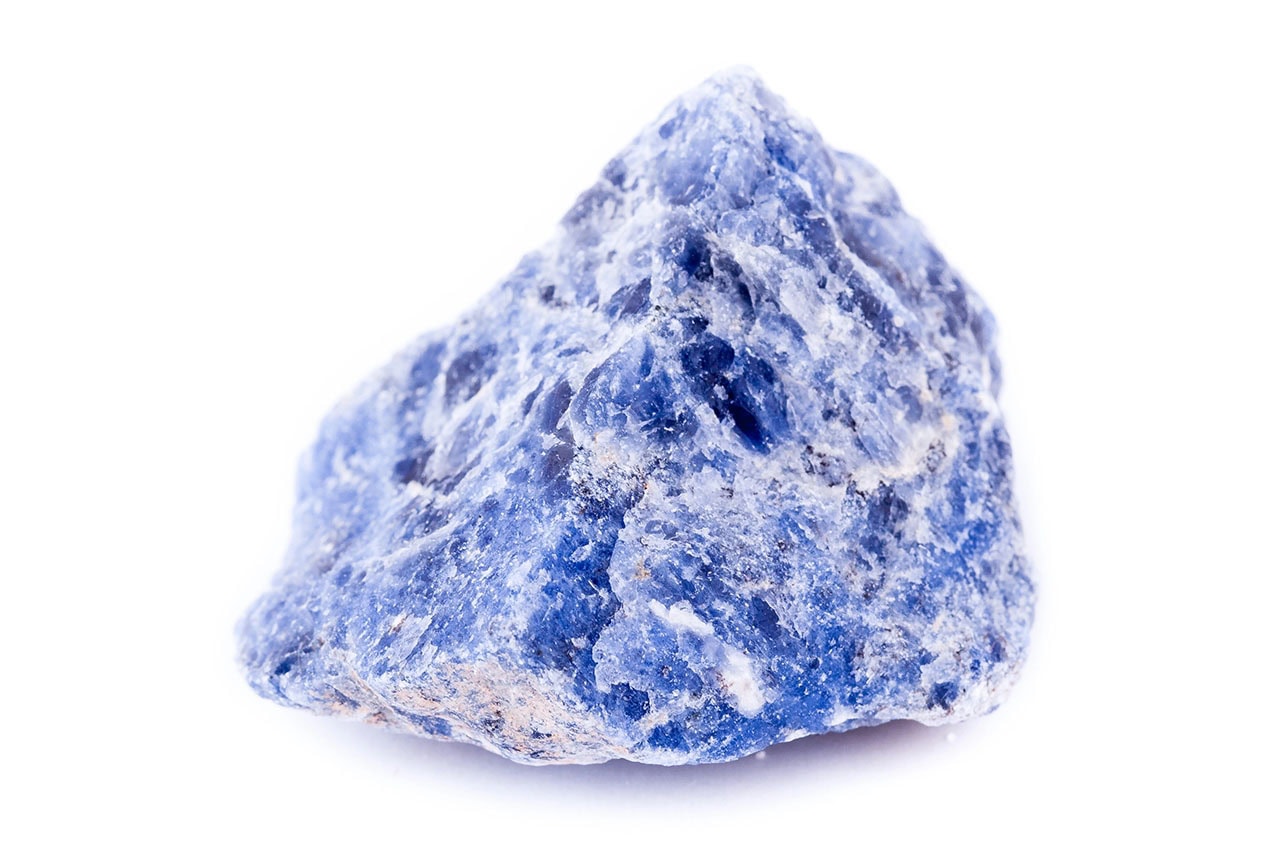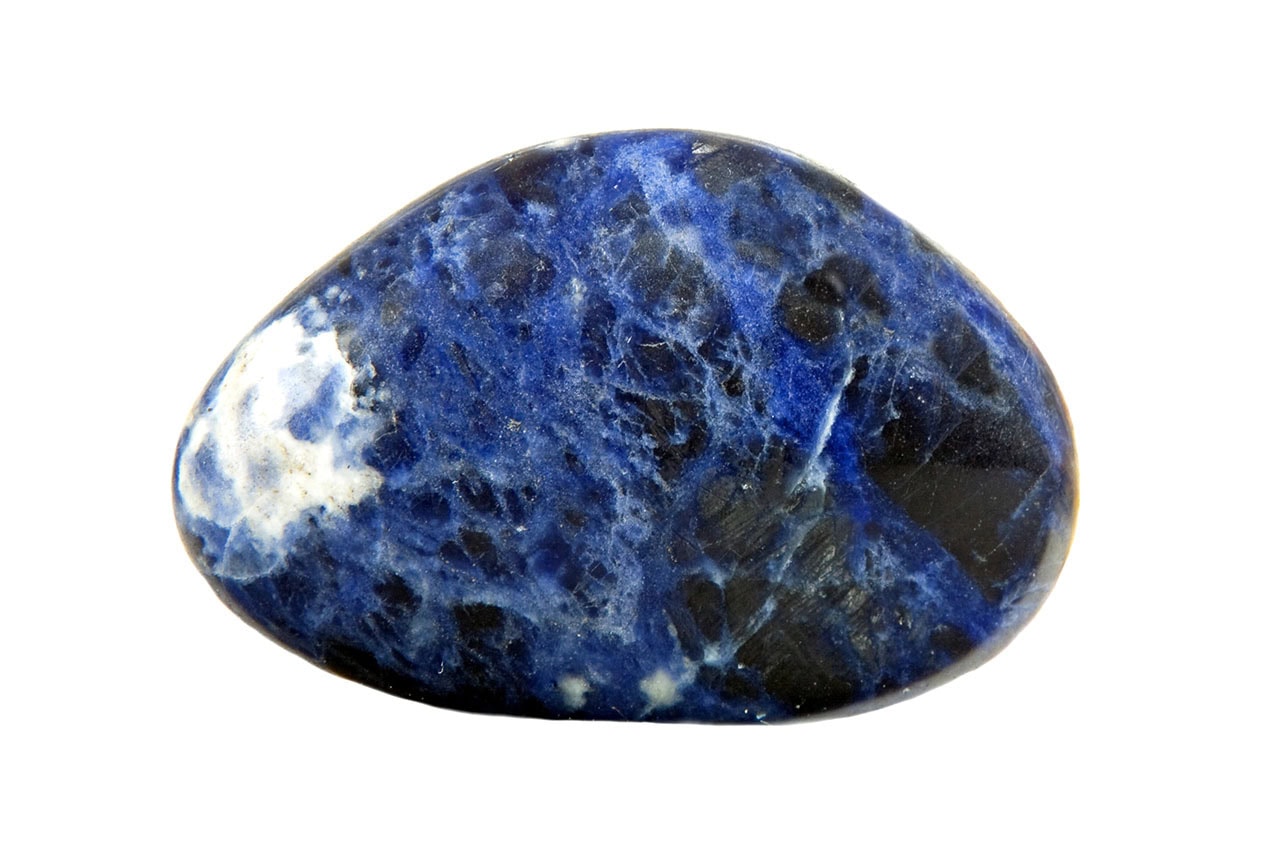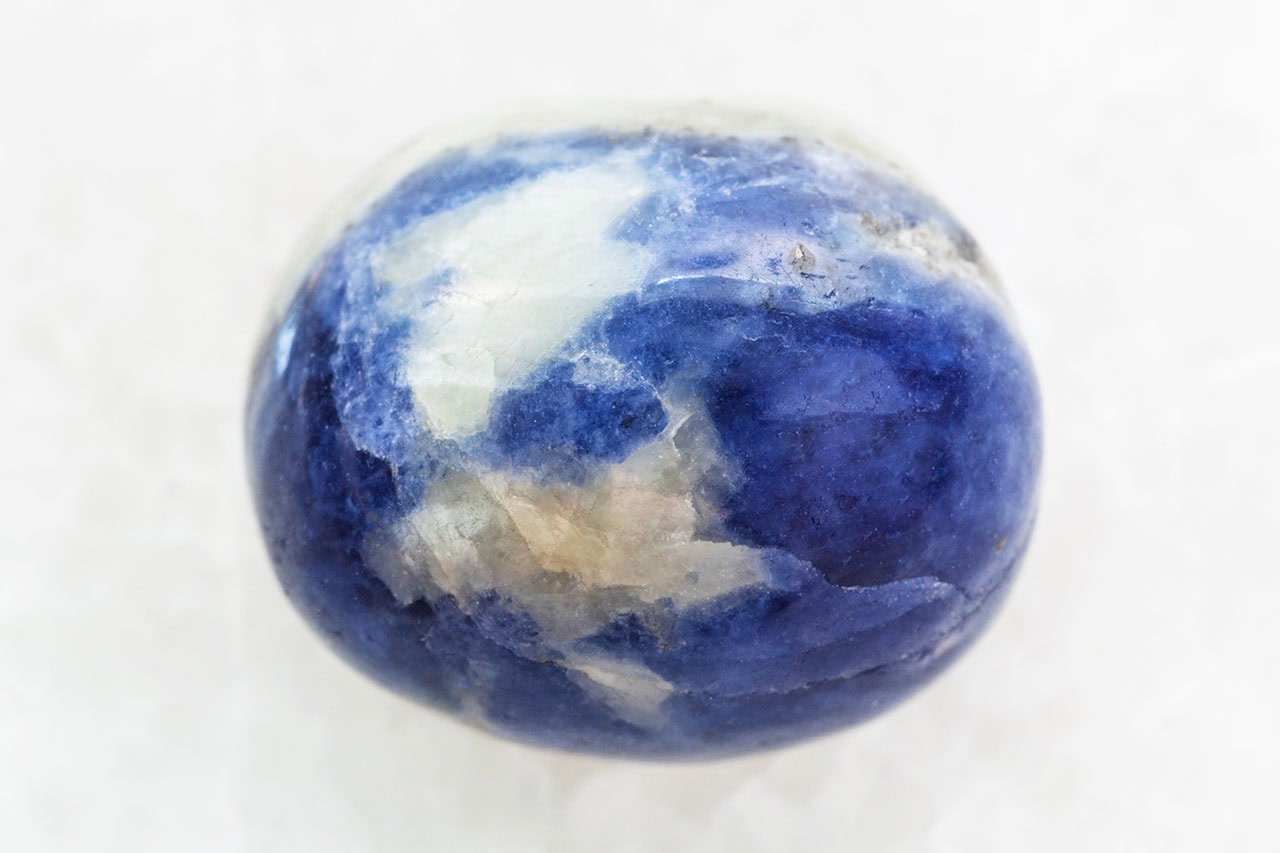Sodalite
Silicate (Tectosilicate)
Royal blue, gray, white, green, pink (hackmanite)
Vitreous to greasy
5.5 - 6
2.27 - 2.33
Isometric (cubic)
Brazil, Canada, Namibia, India, Russia
Common
Na₈(Al₆Si₆O₂₄)Cl₂
In the ice-carved landscapes of Greenland, Inuit peoples discovered a stone that captured the deep blue of Arctic twilight—sodalite, whose rich ultramarine color rivaled the precious lapis lazuli but occurred in massive formations. This sodium-rich member of the feldspathoid family remained largely unknown to the wider world until 1891, when vast deposits discovered in Ontario, Canada during a royal visit earned it the nickname "Princess Blue."
The name sodalite simply refers to its sodium content, but this utilitarian designation belies the stone's profound metaphysical reputation as the "Poet's Stone" or "Stone of Truth." Unlike the golden tongues of persuasion, sodalite encourages authentic communication—words arising from the marriage of logic and intuition rather than manipulation or emotional reaction.
Today, from the conference rooms where executives wear sodalite to enhance clear thinking to the meditation spaces where seekers use it to access inner wisdom, this stone bridges the supposed divide between rational and intuitive intelligence. Its ability to combine the deep blue of spiritual insight with white veining of logical structure makes it the perfect ally for anyone seeking to communicate truth in a world often clouded by deception and misunderstanding.
Properties & Qualities
Physical Properties
Sodalite presents itself through rich royal blue coloration intermixed with white calcite veining, creating patterns reminiscent of lightning against a midnight sky. This distinctive appearance results from the mineral's complex structure incorporating chlorine, which creates the blue color through interaction with sulfur-bearing compounds. The white veining typically consists of calcite or nepheline, creating natural mandalas within the stone.
The mineral rarely forms distinct crystals, instead occurring as massive granular aggregates within igneous rocks. When crystals do form, they display dodecahedral shapes typical of the isometric system. The most prized specimens show deep, uniform blue with minimal white veining, though many practitioners prefer stones with balanced patterns representing the integration of intuition and logic.
A fascinating variety called hackmanite displays tenebrescence—the ability to change color when exposed to sunlight. These specimens shift from pale gray or greenish to pink or purple under UV light, then slowly fade back to their original color in darkness. This reversible photochromism adds another layer to sodalite's reputation as a stone of hidden truths revealed.
Under ultraviolet light, most sodalite fluoresces orange or red, creating a dramatic contrast to its blue daylight appearance. This hidden fire within cool blue depths perfectly captures sodalite's essence—passion and logic united rather than opposed. The stone's relatively low hardness makes it suitable for carving, leading to its use in decorative objects that showcase its color patterns.
Metaphysical properties
Within metaphysical circles, sodalite stands as the premier stone of mental clarity and authentic communication, creating what practitioners describe as a "bridge between head and heart." Unlike stones that emphasize one over the other, sodalite insists that true wisdom emerges from their integration, making it invaluable for those who struggle with either excessive rationality or emotional overwhelm.
The stone's primary resonance with the throat and third eye chakras creates a powerful combination for truth-seeking and truth-speaking. This dual activation helps users not only perceive truth through enhanced intuition but also communicate it clearly without the distortions of ego or emotion. This makes sodalite essential for teachers, writers, and anyone whose work requires translating complex insights into understandable form.
Modern practitioners particularly value sodalite for its ability to calm mental chatter while enhancing focused thinking. Unlike stones that sedate the mind, sodalite organizes thoughts into coherent patterns, making it popular among students, researchers, and anyone engaged in complex problem-solving. This organizing principle extends to emotional patterns, helping identify and release rigid mental loops.
The white veining within blue sodalite is interpreted as representing the integration of spiritual insight (blue) with practical application (white). This visual reminder of necessary balance makes sodalite valuable for those prone to spiritual bypassing or, conversely, those so grounded in logic they dismiss intuitive wisdom.
Meaning & Symbolism
Physical meaning
In the physical realm, sodalite embodies the principle of structured flow—its massive formation showing how individual components can maintain identity while creating cohesive wholes. This mirrors successful group dynamics where individual intelligence combines into collective wisdom without losing personal contribution.
The stone's association with sodium—an element essential for neural function—connects it symbolically to mental processes and communication networks. Just as sodium enables nerve impulses, sodalite allegedly facilitates the flow of ideas between mind and mouth, thought and expression, individual and group consciousness.
For those in fields requiring both analytical and creative thinking, sodalite provides energetic support for whole-brain integration. Its blue color resonates with intuitive right-brain functions while its crystalline structure supports logical left-brain processes, making it ideal for innovators who must dream and implement.
The mineral's formation in igneous rocks—born from fire but cooling into stable form—represents passion structured into sustainable action. This makes sodalite an ally for those with brilliant ideas who struggle with practical implementation, providing the grounding needed to manifest visions.
Spiritual meaning
Sodalite's spiritual significance centers on its role as the "Stone of Inner Truth," helping practitioners distinguish between authentic inner knowing and the countless voices of conditioning, fear, and desire that masquerade as intuition. This discernment makes it invaluable for spiritual seekers navigating the often confusing landscape of inner guidance.
The stone's deep blue color connects it to the archetypal realm of spiritual wisdom, but unlike stones that facilitate escape into transcendent realms, sodalite insists on bringing cosmic insights down to earth. This grounding of spiritual truth into practical wisdom makes it essential for those walking the path of embodied spirituality.
Different traditions interpret sodalite's veining patterns as maps of consciousness—the white lines representing neural pathways or energy meridians through which divine intelligence flows into human awareness. This positions sodalite as a tool for conscious evolution, helping develop new pathways for processing spiritual information.
The mineral's ability to fluoresce under UV light serves as a metaphor for hidden spiritual gifts activated by the right conditions. Just as ultraviolet reveals sodalite's hidden colors, spiritual practice reveals latent abilities—but like hackmanite's tenebrescence, these gifts require regular activation to maintain their brightness.
Healing Benefits
Physical healing
Traditional healing applications for sodalite focus on its perceived effects on the throat and communication systems. Alternative healers place sodalite on the throat during sessions aimed at addressing voice problems, though effects likely relate more to the relaxation response than direct physical action.
Contemporary crystal healers frequently use sodalite for what they term "metabolic balancing," based on its sodium content and blue color association with the thyroid. Practitioners place stones on the throat during energy sessions focused on metabolism regulation, though such practices remain entirely within complementary medicine.
The stone's calming properties have led to its use in addressing blood pressure issues in alternative healing. Some practitioners create gem elixirs using the indirect method, believing sodalite-charged water helps balance bodily fluids. However, these applications should never replace medical treatment for hypertension.
Energy workers report using sodalite for lymphatic system support, placing stones at key lymph points during drainage sessions. The stone's association with flow and filtration makes it symbolically appropriate for supporting the body's cleansing systems, though benefits likely stem from the overall relaxation response.
Emotional healing
The emotional healing properties of sodalite center on its ability to create what therapists call "emotional objectivity"—the capacity to observe feelings without being overwhelmed by them. This makes it invaluable for those whose emotions cloud judgment or whose logic suppresses necessary feeling.
For individuals struggling with panic attacks or anxiety, sodalite provides a different approach than purely calming stones. Rather than sedating anxiety, it helps users understand anxiety's message while preventing spiral into panic. This cognitive approach to emotional healing appeals to those who find purely feeling-based approaches overwhelming.
The stone excels at healing communication wounds—experiences where expression was punished or truth-telling led to rejection. Sodalite helps rebuild trust in one's voice while developing discernment about when, how, and with whom to share truth. This makes it valuable for those recovering from relationships where authentic expression was dangerous.
Different patterns within sodalite address specific needs: predominantly blue stones for those needing more intuitive flow, heavily veined specimens for those requiring structure and logic, balanced patterns for integrating both aspects.
Spiritual healing
In spiritual healing contexts, sodalite functions as what practitioners call a "consciousness organizer," helping integrate spiritual experiences into coherent understanding rather than leaving them as disconnected mystical moments. This makes it essential for those receiving downloads or revelations they struggle to comprehend or apply.
Advanced practitioners utilize sodalite for clearing and activating the alta major chakra—the "zeal point" at the base of the skull governing higher mental functions. This lesser-known energy center bridges ordinary and cosmic consciousness, with sodalite helping establish stable connection between the two.
For those experiencing information overload from spiritual studies, sodalite provides filing system for consciousness. Rather than accumulating more spiritual data, it helps organize existing knowledge into usable wisdom. This prevents the spiritual materialism of collecting experiences without integration.
The stone's connection to group consciousness makes it valuable for healing collective thought patterns. Meditation groups using sodalite report enhanced telepathic connection and shared insight, while maintaining individual clarity rather than merging into groupthink.
Use & Care
How to use
- Throat chakra placement: Lie down and place on throat for communication
- Study aid: Keep on desk while learning for enhanced comprehension
- Meditation stone: Hold during meditation for mental clarity
- Communication talisman: Wear for important conversations
- Writer's tool: Keep near while writing for clear expression
- Dream clarity: Place under pillow for lucid, memorable dreams
- Group harmony: Place in meeting spaces for collective wisdom
- Third eye activation: Place on forehead for intuition development
- Worry stone: Carry tumbled piece for anxiety relief
- Bath companion: Add to bath (in mesh bag) for mental clearing
- Public speaking: Hold before presentations for confidence
- Conflict resolution: Use during difficult discussions
How to cleanse
- Sound cleansing: Bells or singing bowls very effective
- Moonlight bathing: Leave under full moon overnight
- Smoke clearing: Pass through sage or palo santo smoke
- Breath work: Exhale mental clutter while holding stone
- Running water: Brief rinse under cool water
- Selenite charging: Rest on selenite for purification
- Visualization: Imagine blue light clearing all static
- Salt proximity: Place near (not on) sea salt briefly
- Regular cleansing: Clean after intense mental work
- Gentle methods: Avoid harsh cleansing due to moderate hardness
How to charge
- Morning meditation: Charge during sunrise contemplation
- Sound activation: Use throat chakra frequency (741 Hz)
- Blue candle: Place near blue flame for color resonance
- Intention speaking: Speak intentions aloud to stone
- Crystal cluster: Rest on clear quartz or amethyst
- Sacred texts: Place on wisdom teachings overnight
- Group chanting: Charge during mantra or song circles
- Air element: Leave in fresh breeze for clarity
- Mercury timing: Charge on Wednesdays for communication
- Brief charging: Sodalite holds charge well
Combining with other stones
- Lapis Lazuli: Enhances wisdom and spiritual truth
- Clear Quartz: Amplifies mental clarity and communication
- Amethyst: Adds spiritual protection to mental work
- Blue Lace Agate: Gentles communication for sensitive topics
- Fluorite: Enhances mental organization and focus
- Amazonite: Balances logic with emotional intelligence
- Howlite: Calms mental chatter for clearer thinking
- Celestite: Opens higher communication channels
- Azurite: Deepens intuitive and psychic abilities
- Chrysocolla: Adds heart wisdom to communication
Identification
Can be mistaken for
- Lapis Lazuli: Similar blue but lapis contains pyrite flecks
- Lazulite: Blue color similar but different crystal structure
- Dumortierite: Blue fibrous mineral sometimes confused
- Azurite: Deeper blue and reacts to acid unlike sodalite
- Blue Aventurine: Contains mica sparkles sodalite lacks
- Dyed Howlite: Often dyed blue to imitate sodalite
- Blue Calcite: Softer and different crystal structure
- Synthetic Sodalite: Lab-created versions exist
How to spot a fake
- White veining: Natural sodalite shows irregular white patterns
- Hardness test: Should not scratch easily (5.5-6 hardness)
- UV reaction: Most sodalite fluoresces orange under UV
- Weight check: Lighter than many blue stones (SG 2.27-2.33)
- Pattern variety: Natural shows unique patterns, not uniform
- Dye test: Acetone on cotton swab reveals blue dye
- Temperature: Natural stone stays cool longer
- Price point: Natural sodalite affordable—overpricing suspicious
- Hackmanite test: Some specimens show color change
- Source verification: Buy from reputable mineral dealers



